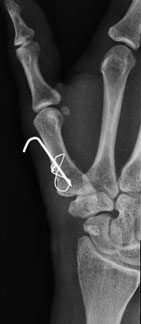
Basilar Thumb Pain in Young Individuals
Arthritis commonly affects the base of the thumb. Older patients, or those with more advanced arthritis, are well-treated by the LRTI procedure, which is well-covered in the ‘Basilar Thumb Arthritis’ section of this website. While the LRTI is extremely effective, it may be more surgery than a younger patient with less-advanced arthritis requires.
Treatment always starts with non-operative management, including avoiding pinching and gripping ‘small’. When grasping or pinching a small object, for every 1 pound of force applied to the thumb tip, the basilar joint experiences 12 pounds of force. Pinching and gripping ‘big’ minimize the forces across the basilar thumb joint. Big, thick pens with rubber grips on them are much easier on this joint than are small, metal pens. Kitch-aid or simlar devices can slip over jar covers to make them larger and easier to hold. Devices that slip over keys to make turning them easier can be purchased. http://www.ncmedical.com/item_180.html Whenever gripping or pinching is necessary, try to make the object bigger.
A splint can also be helpful. Most patients prefer a soft, neoprene, rubber-like splint that doesn’t interfere much with hand function. A steroid injection can also provide good relief. If the symptoms are mild, these measures may be all that is needed. However, unfortunately, they will not provide permanent relief from the pain of more advanced arthritis.
If non-operative management, including activity modification, a splint and an injection fail to provide acceptable pain relief, younger patients may desire surgical treatment to relieve pain when using the hand.
The First Metacarpal Osteotomy is a simple procedure that provides predictable pain relief for younger patients with less-advanced basilar thumb arthritis. First metacarpal osteotomy involves cutting the first metacarpal (the long bone of your thumb) and extending it 30°. It is then fixed in its new position with 2 wires, one that stays inside and one that protrudes through the skin and is removed after 4-5 weeks (which doesn’t hurt much at all). After surgery, a cast is worn for five weeks. Throughout this time it is important to move the tip of the thumb at least 3 times a day to prevent the thumb’s tendons from scarring down.
The First Metacarpal Osteotomy is very effective and has passed the test of time. This procedure transfers stress from the arthritic areas of the basilar joint to areas of the basilar joint that are still normal, or have only mild arthritis. This decreases the stress going through the most arthritic areas, decreasing pain. The first metacarpal osteotomy does not remove any arthritis already present. (www.cantravelwilltravel.com) Therefore, activities that are very stressful on the thumb (massage, forceful use of certain tools, etc.) may have to be avoided indefinitely. Many people often have one activity that they have to give up. Following first metacarpal osteotomy, any given stress on the basilar joint will lead to less pain. Another way to say this is that more stress can be placed on the thumb before pain occurs. Any arthritis present will still continue to progress, but probably at a slower pace. Therefore, this surgery may help to delay the need for future surgery. The first metacarpal osteotomy will not be effective in cases of more advanced arthritis because there’s no remaining normal joint to ‘off-load’ stress onto.
Because the thumb’s metacarpal bone is extended following this procedure, thumb flexion will be decreased a little, but this is rarely a problem. Close inspection of the thumb will detect a slight angle to it, but this is rarely noticed unless actually looked for, i.e. the angulation is not usually obvious. There is some, but usually not a lot, of hand therapy required once the cast is removed. A removable splint is then used as needed.
In summary, basilar thumb pain can usually be successfully treated in young patients without advanced arthritis by a First Metacarpal Osteotomy, an outpatient procedure that ‘burns no bridges’ and still allows for any future procedures, such as the LRTI.
LRTI Procedure

First Metacarpal Osteotomy

After wire is removed
